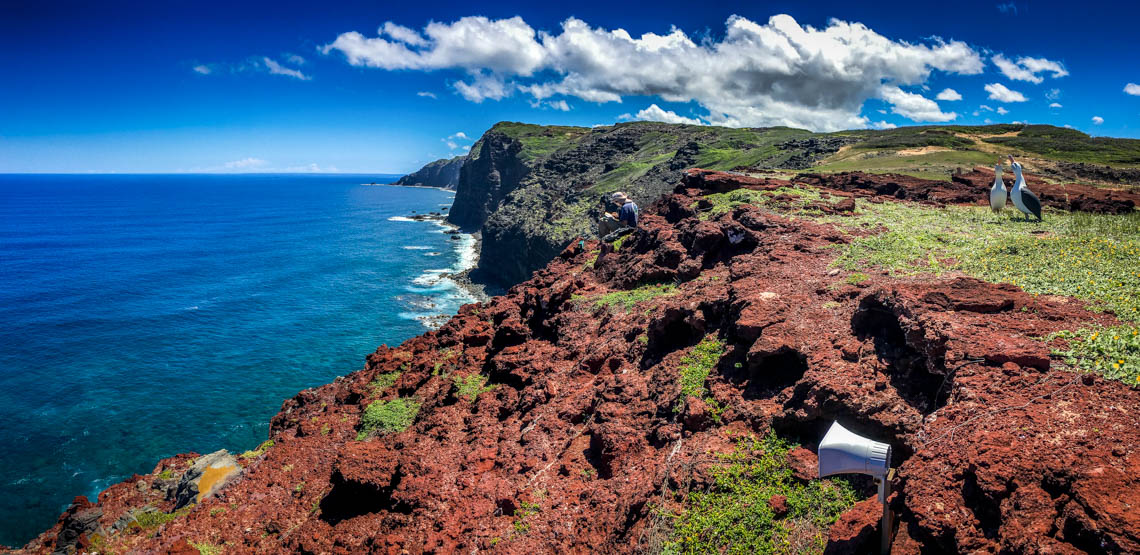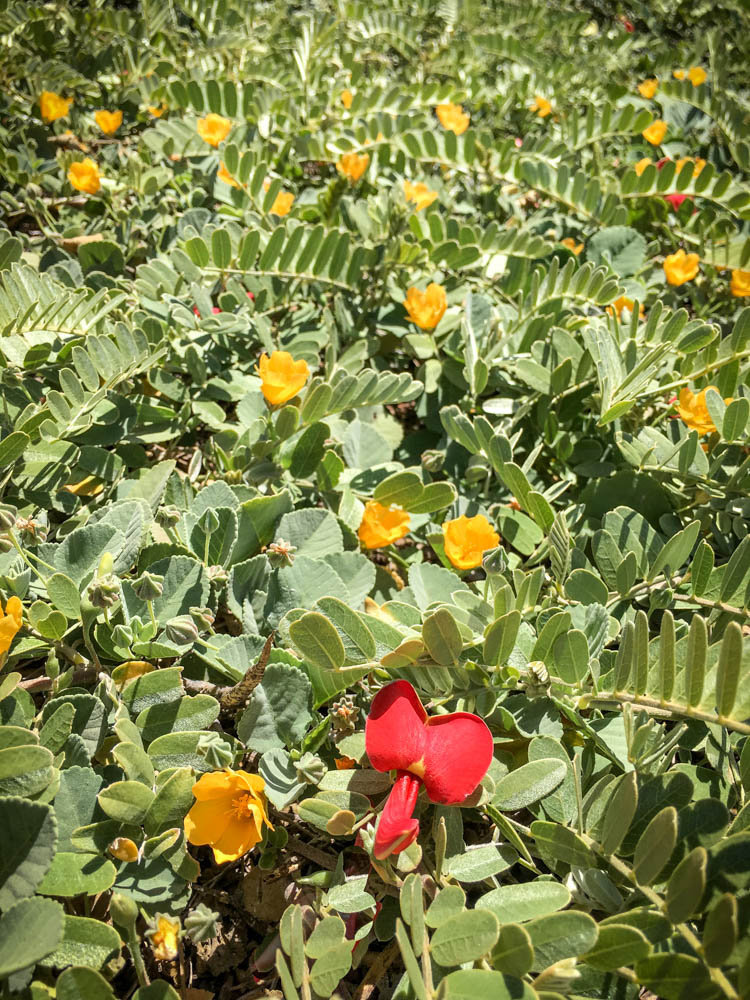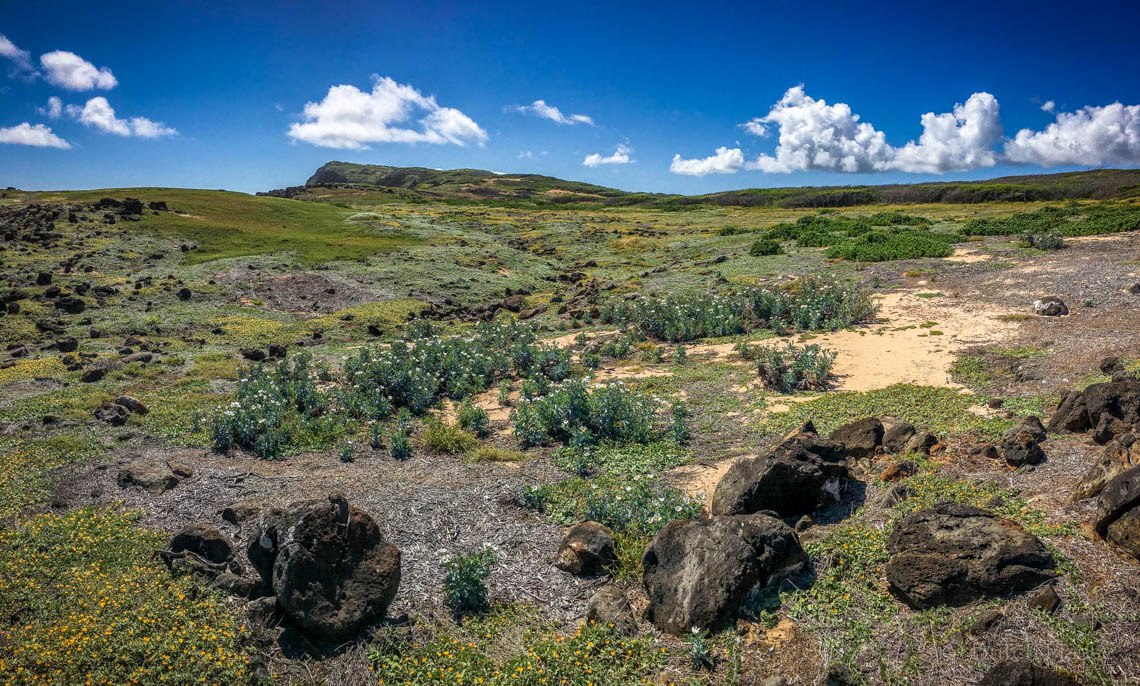
On the windswept, northwestern corner of Moloka’i there is an old cattle pasture that, until recently, was covered in kiawe, buffelgrass, and lantana. But underneath the invasive plants, seeds of native species lay waiting, ready to grow if given the chance. Endangered Hawaiian insects found refuge in pockets of the sea cliffs. Seabirds patrolled the coastlines. Their wait may be over.
In 2008 the Molokaʻi Land Trust began to manage Mokio, five miles of coastline between the state-owned Ilio Point and The Nature Conservancy’s Moʻomomi Preserve. This former pastureland was never developed and is rich in both cultural and biological resources. Seasonal wetlands support the largest population of an endangered fern, ʻihiʻihilauākea, or four-leaf clover fern, in the State. Adze quarries and pre-contact Hawaiian housing sites remain relatively intact. It is a promising seabird nesting habitat, already in use by the koaʻe ʻula and koaʻe kea (red-tailed and white-tailed tropicbirds) that nest in the cliff faces and noio (black noddy) that raise their young in caves. But years of cattle and deer traffic have taken a toll on the native plant community.
The first step in restoring the area: fencing out large grazing animals. “Sixty acres are fenced,” says Butch Haase, executive director of the Molokai Land Trust. “We’ve converted a kiawe, lantana, and buffelgrass-dominated landscape into a native-dominated landscape.” Seeds of native coastal plants have begun to sprout after decades of dormancy. Volunteers planted seedlings farther inland where the seed bank was depleted by years of cattle grazing. Their efforts are proving successful: carpets of yellow-flowered nehe, ʻilima, and a rare orange ʻōhai now thrive where kiawe and other invasives once grew.
“Their efforts are proving successful: carpets of yellow-flowered nehe, ʻilima, and a rare orange ʻōhai now thrive where kiawe and other invasives once grew.”
Native habitat attracts native critters. These native coastal plants feed and house critically endangered Hawaiian yellow-faced bees. The low-growing vegetation is the perfect place for seabirds to forage. And they do – the variety of seabirds seen at Mokio rivals that of another birding hotspot in the Hawaiian Islands – Kilauea Point on Kauaʻi. Uau Kane (wedge-tailed shearwater), a (both red-footed and brown boobies), and Kaupu (black-footed albatross) are nesting here. Moli – the Laysan albatross – has been sighted along the northern coast of Molokai, landing at Ilio, Anapuka, and Kalaupapa. This led Haase and his crew to wonder if perhaps albatross belonged at Mokio, too.

With rising sea levels threatening primary albatross nesting grounds in the Northwest Hawaiian Islands, scientists are trying to increase nesting sites in the main Hawaiian Islands. So Haase, working with the American Bird Conservancy, Maui Nui Seabird Recovery Project, the US Fish and Wildlife Coastal Program, and the Department of Land and Natural Resources, deployed a fourteen albatross decoys complete with pre-recorded albatross calls. Within ten days an albatross had landed, scraping around to investigate a potential nesting site.
This albatross was alone, checking out new territory as young albatross often do, but the amazingly quick response rate is promising. Haase and the rest of the project team hope that within two years albatross could be nesting at Mokio.
That solidifies a deadline for another project at Mokio: the construction of a predator-proof fence to protect ground-nesting seabirds from feral cats, dogs, mongoose, rats, and mice. These predators attack adults and eat their eggs or hatchlings. (Presently, labor-intensive trapping keeps the predator population down). When the fence is complete it will protect 85 acres of potential nesting habitat for Hawaiian seabirds as well as migratory seabirds like kōlea and the kioea, bristle-thighed curlew, a shorebird that cannot fly during its winter molt in Hawaii.

The changes at Mokio are dramatic – a cattle pasture transformed into a growing seabird colony now full of native plants. The success so far highlights the resilience of Hawaiian species and their ability to recover when invasive plants and animals are removed. Work at Mokio is ongoing and you can help: Molokai Land Trust welcomes volunteers, both residents of Molokai and visitors from off-island. If you would like to help in recovery efforts, send an email to volunteersmlt@gmail.com. Follow the progress of the project at molokailandtrust.org and look for them on Facebook.
This article was originally published in the Maui News on May 13th, 2018, as part of the Kia‘i Moku Column from the Maui Invasive Species Committee.
Read more Kiaʻi Moku articles.
